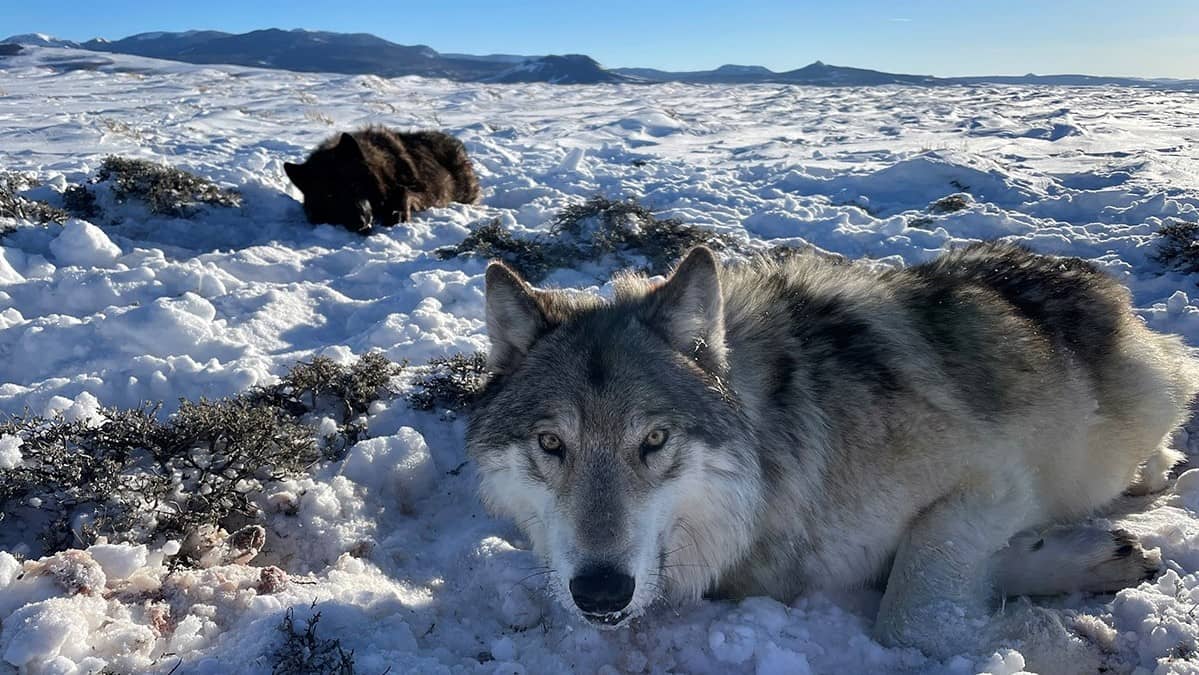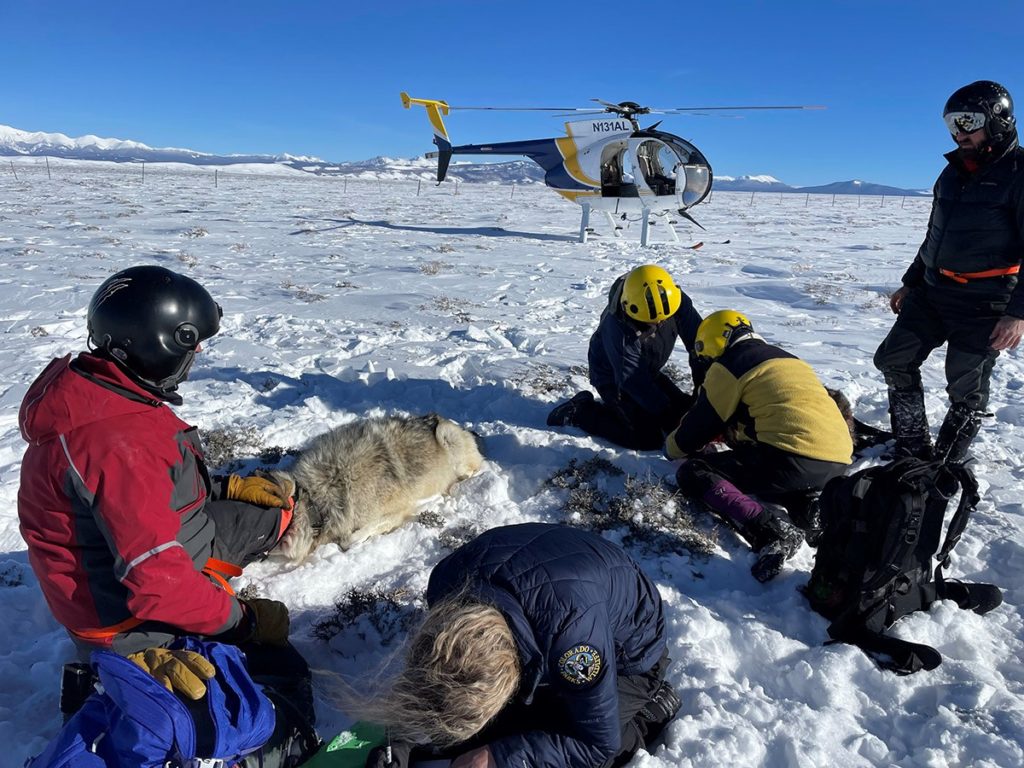
UPDATE at 11 a.m. Tuesday, Feb. 7, 2023.
The collar that was placed on the male wolf 2101 in Jackson County has fallen off. It was put on last Thursday, Feb. 2. Travis Duncan with Colorado Parks and Wildlife writes, “The collar on male wolf 2101 came off on Sunday in the pack’s known range in North Park.”
Colorado Parks and Wildlife are meeting in Rifle today to get public feedback on the Draft Wolf Restoration and Management Plan. The collar falling off will be discussed after public comment today.
By Shannon Lukens. (CPW placed GPS collars on two wolves in North Park on Feb. 2. Male wolf 2101 has a gray coat and is in the foreground on the right. Male wolf 2301 has a black coat and is in the background on the left. Photos courtesy Colorado Parks and Wildlife.)
Two wolves have been collared in North Park. It happened Thursday, Feb. 2. One was the gray male wolf 2101 that was recaptured two years after he was first captured. His GPS collar had failed. The second is presumed to be one of the six black pups produced by the male wolf and the female wolf 1084. The wolves were darted with a tranquilizer from a helicopter. CPW crews on the ground put the tracking collars on them.

CPW placed GPS collars on two wolves in North Park on Feb. 2. CPW’s team was doing wolf capture and collaring work in conjunction with elk and moose capture efforts for ongoing research studies in the area.
CPW Species Conservation Program Manager Eric Odell says both animals appear to be in good health.
“Refitting 2101 and having a second GPS collar will allow our biologists and wildlife managers to continue learning about the behavior of these wolves,” said CPW Acting Director Heather Disney Dugan.
The wolves in Jackson County naturally migrated to Colorado and are not a result of wolf reintroduction efforts.
CPW asks that if you ever think you see a wolf, please report it on the wolf sighting form on their website.
Colorado Parks and Wildlife officials are in Rifle Tuesday for the next meeting on the Draft Wolf Restoration and Management Plan. The meeting is from 8:30 a.m. to 3 p.m. Tuesday, Feb. 7, at the Colorado Mountain College campus in Rifle. Members of the Stakeholder Advisory group are collecting public feedback on the state’s plan to reintroduce gray wolves in Colorado by the end of the year. Those who show up can speak on a first-come, first-served basis. You can also submit comments online, through Feb. 22. There is also a meeting scheduled for Steamboat Springs on April 6.
Here is the full press release from Colorado Parks and Wildlife; Feb. 3, 2023.
WALDEN, Colo. – Colorado Parks and Wildlife placed GPS collars on two wolves in North Park, Colorado on Thursday, Feb. 2. The male wolf 2101 was recaptured two years after his initial capture. The other wolf collared was male 2301, presumably one of six pups produced by female wolf 1084 and male wolf 2101 in 2021.
“Both animals were caught together in an area of North Park where we have been receiving reports from the public in the past couple of weeks,” CPW Species Conservation Program Manager Eric Odell said. Odell was part of the capture team working to collar wolves in North Park this week along with CPW Wildlife Research Scientist Ellen Brandell and CPW Wildlife Veterinarian Pauline Nol. “We would like to thank the public for sending in their wolf sightings.”
CPW’s team was doing wolf capture and collaring work in conjunction with elk and moose capture efforts for ongoing research studies in the area.
“2101’s collar had failed and we could see it was damaged. Wolves are rough on collars and that’s to be expected that in time collars will fail,” said Odell.
“Refitting 2101 and having a second GPS collar will allow our biologists and wildlife managers to continue learning about the behavior of these wolves,” said CPW Acting Director Heather Disney Dugan.
During the collaring effort, a CPW-contracted company safely darted the animal with a tranquilizer from a helicopter, allowing the collar to be fitted by field staff on the ground.
“Both animals were given a health exam during the collaring process and appear to be in good health,” said Odell.
It is worth noting that, while collars provide valuable information, they only provide a snapshot and are not monitored in real time. The primary tools used by wildlife officers are field observations of physical evidence such as wolf prints and scat during field investigations to verify the presence of wolves on the landscape.
CPW also encourages the public to use its wolf sighting form if they see a suspected wolf. Any personal observations, photos or videos taken can help inform CPW staff and fill in the gaps as to wolf activity in the state.
These collaring efforts occurred on the known wolves in Jackson County that naturally migrated to the state and are not the result of wolf reintroduction efforts. No wolves have been reintroduced under Proposition 114 – now state statute 33-2-105.8.